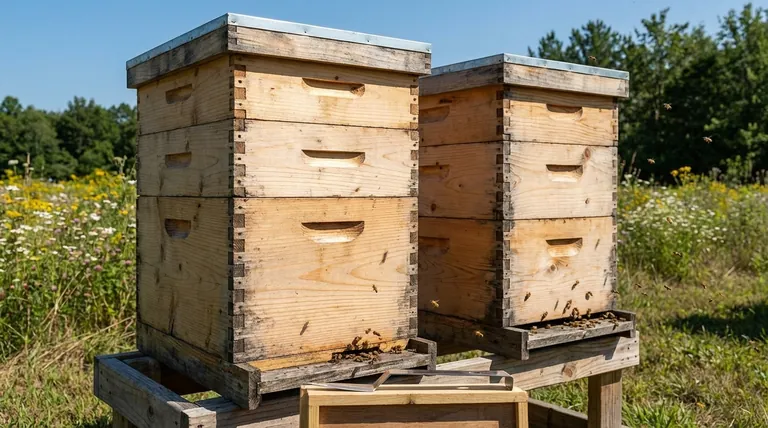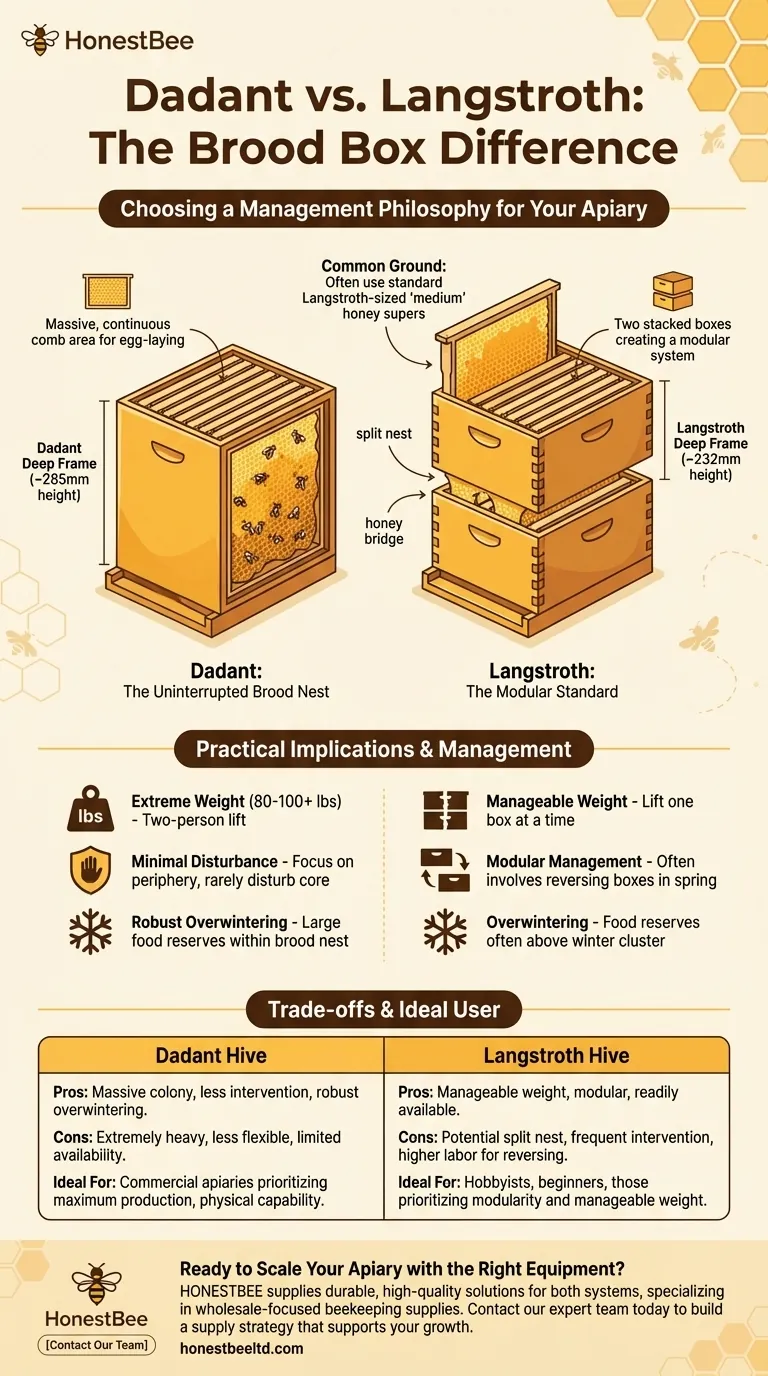At its core, the difference between a Dadant and a Langstroth hive is the size of the brood box. While both are modern, vertically stacked hives that use removable frames, the Dadant was designed as a modification of the Langstroth to feature a significantly deeper brood chamber. This single design choice creates a cascade of differences in hive management philosophy, weight, and beekeeping strategy.
The decision between Dadant and Langstroth is not about which is "better," but about choosing a management philosophy. Langstroth prioritizes modularity and lighter components, while Dadant prioritizes a large, uninterrupted brood nest to foster a massive colony with less intervention.

A Tale of Two Boxes: Core Design Differences
The foundational differences in dimension and frame size dictate how a beekeeper interacts with the colony throughout the year.
The Langstroth: The Modular Standard
The Langstroth hive is the most popular system in North America and many other parts of the world. Its defining feature is standardization around a single box footprint, typically holding 8 or 10 frames.
Brood chambers are commonly made of two stacked "deep" or "medium" boxes. This modularity makes components interchangeable and relatively light.
The Dadant: The Uninterrupted Brood Nest
The Dadant hive utilizes a single, much deeper brood box. This box is taller than a Langstroth deep and, in its European configuration (Dadant-Blatt), often wider, holding 12 frames instead of 10.
The core philosophy is to provide the queen with a vast, continuous area for egg-laying that she will rarely need to leave, mimicking a more natural nest cavity.
Frame Dimensions and Comb Area
A deep Dadant frame is significantly taller than a deep Langstroth frame (approximately 285mm vs. 232mm).
This extra height on a Dadant frame provides more contiguous comb space. This encourages the queen to lay in large, solid patterns and can support the development of a very large workforce without the "barrier" that can form between two separate Langstroth brood boxes.
Honey Supers: A Point of Convergence
While the brood chambers are distinct, many beekeepers use standard Langstroth-sized "medium" supers for honey collection on top of both Dadant and Langstroth hives.
This makes honey management and extraction equipment more universal and keeps the weight of honey-filled boxes manageable.
Practical Implications for the Beekeeper
The design choices of each hive directly impact the physical labor and management techniques required from the beekeeper.
Weight and Heavy Lifting
This is the most significant practical difference. A single, full Dadant brood box can easily exceed 80-100 pounds (36-45 kg), making it a two-person lift for most people.
In contrast, a Langstroth system breaks this weight into two more manageable boxes. Beekeepers only ever need to lift one deep box at a time.
Brood Nest Management
Langstroth management often involves "reversing" the two brood boxes in the spring to encourage the colony to expand upward. This is a management task created by the system itself.
Dadant management is centered on leaving the single brood box alone as much as possible. Inspections focus on the periphery, and the core nest is rarely disturbed, which proponents argue leads to a less stressed, more productive colony.
Overwintering Strategy
The larger volume of the Dadant brood box allows the colony to store a significant amount of honey and pollen directly beside and above the winter cluster.
Many beekeepers in cold climates favor this, as it provides a robust food source within the warmest part of the hive, reducing the risk of the cluster starving just inches away from food.
Understanding the Trade-offs
Neither system is perfect. Choosing one means accepting a specific set of advantages and disadvantages.
The Langstroth Dilemma: A Split Nest
The primary critique of the two-box Langstroth brood chamber is that it can create an artificial division in the nest. Bees often build a "honey bridge" in the upper part of the bottom box and the lower part of the top box, which can discourage the queen from crossing between them.
The Dadant Challenge: Weight and Inflexibility
The overwhelming disadvantage of the Dadant hive is the extreme weight of its brood box. This is a non-starter for many hobbyists or beekeepers with physical limitations.
Furthermore, its large size is less flexible for managing smaller colonies or making splits, where the Langstroth's smaller, modular components are a clear advantage.
Equipment Availability
In North America, Langstroth is the undisputed standard. Equipment is readily available, interchangeable between suppliers, and generally less expensive.
Dadant equipment, while available, is less common, can be more expensive, and offers fewer choices for suppliers. This is reversed in parts of Europe where the Dadant is more prevalent.
Making the Right Choice for Your Operation
Your choice should be guided by your physical ability, management goals, and local equipment availability.
- If your primary focus is modularity and manageable weight: The Langstroth system is the clear and logical choice.
- If your primary focus is a large, minimally disturbed brood nest and maximum colony size: The Dadant system is superior, provided you can safely handle its weight.
- If you are a beginner in North America: Starting with Langstroth is often the wisest path due to the vast availability of mentors, educational materials, and compatible equipment.
Ultimately, the best hive is the one that allows you to be a consistent and effective steward for your bees.
Summary Table:
| Feature | Langstroth Hive | Dadant Hive |
|---|---|---|
| Brood Chamber | Two stacked 'deep' or 'medium' boxes | One single, very deep box |
| Management Philosophy | Modularity, lighter weight, frequent intervention | Large, uninterrupted brood nest, minimal disturbance |
| Key Advantage | Manageable weight, equipment availability, flexibility | Supports massive colony size, robust overwintering |
| Key Disadvantage | Can create a 'split' nest, more frequent management | Extremely heavy brood box, less flexible for splits |
| Ideal For | Hobbyists, beginners, beekeepers prioritizing manageable weight | Commercial apiaries focused on maximum colony production |
Ready to Scale Your Apiary with the Right Equipment?
Whether your operation is best suited for the modular Langstroth system or the high-production Dadant hive, HONESTBEE supplies the durable, high-quality beekeeping supplies and equipment you need to succeed.
We work directly with commercial apiaries and beekeeping equipment distributors to provide wholesale-focused solutions that maximize efficiency and productivity.
Let's discuss your specific needs and build a supply strategy that supports your growth.
Contact our expert team today to get a quote
Visual Guide

Related Products
- HONESTBEE Professional Long Handled Hive Tool with Precision Cutting Blade
- HONESTBEE Advanced Ergonomic Stainless Steel Hive Tool for Beekeeping
- Langstroth Bee Hives Bee Keeping Box for Beginners Beekeeping
- Professional Dual-End Stainless Steel Hive Tool for Beekeeping
- Wholesales Dadant Size Wooden Bee Hives for Beekeeping
People Also Ask
- What is a hive tool used for in beekeeping? Your Essential Guide to Hive Management
- What are the basic tools for beekeeping? Essential Starter Kit for Safe & Successful Hive Management
- What is the hive tool used for? The Essential Multi-Tool for Every Beekeeper
- How should beekeepers handle bees when using a hive tool? Master Calm, Deliberate Techniques
- What tools are used for cleaning frames? A Beekeeper's Simple 4-Tool Guide



















